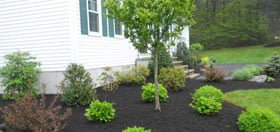Cool nights and shorter days are the ideal time to overseed, fertilize, lime and aerate. Fall is the best time to tend to your lawn for a better result in Spring. In Fall, the roots grow longer resulting in a stronger, thicker lawn.
Overseeding
Remember, a dense lawn has fewer weeds! Overseeding will create a thicker, stronger lawn and choke the weeds right out. Choose the right seed for the area you’re working on. There are shade grasses, sun grasses, slow growing grasses, low maintenance grasses and even high maintenance grasses that require lots of fertilizer and water. So be careful which bag you pick up!
Fertilizing
Two applications of fertilizer in the Fall are ideal. In early September put down a weed and feed fertilizer to help get rid of the weeds and increase and strengthen the grass. In late October or early November, after the grass stops growing and before the ground freezes, put down another application. A slow release fertilizer is recommended going into Winter in order to feed your lawn throughout the Winter season.
Lime
You’ll want to do a pH test of your soil to determine how much lime the soil needs. Yards with lots of pine trees and/or shade will require more lime, or more treatments of lime, than a sunny yard. If you don’t do a soil test, the normal rate should be 50 to 100 pounds of lime per thousand square feet every 2 years. Putting it down in fall is preferred because rain, snow, and freezing and thawing of the soil help work the limestone into the soil.
Aerating
With compact soil there’s less air and water, roots can’t grow and earthworms can’t get through. In dry years, soil compaction can lead to stunted, drought stress plants due to decreased root growth; in wet years, it causes the grass to drown. Fall core aeration reduces soil compaction and allows water and oxygen in. Core aeration stimulates growth and reduces moss by allowing the moist soil to dry out.
Mowing
The cool season grasses of New England should be cut no lower than 2 ½”. If the grass is kept too long into the winter it mats down under the snow and causes damage and snow mold





